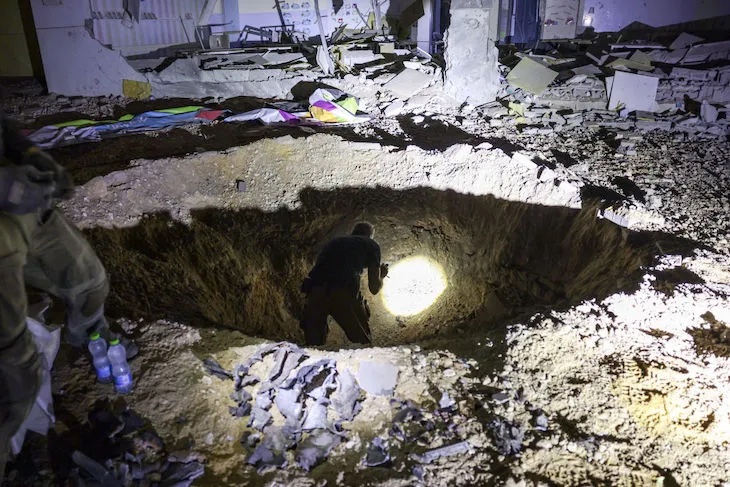When Iran attacked Israel last week with a barrage of missiles, one thing was certain: Israel would hit back hard. Ten days on, that response has still not come. Yoav Gallant, Israel’s defense minister, has warned that the retaliatory strike on Iran will have an element of surprise. Israel’s attack, he said, “will be deadly, precise and above all surprising. They will not understand what happened and how it happened, they will see the results.”
Gallant knows that this element of surprise is critical; without it, Israel may have insufficient conventional capability to land a decisive first-blow strike.
This weakness became apparent following Iran’s missile attack on October 1, in which dozens of Iranian missiles penetrated Israel’s sophisticated anti-missile defenses. The Iranians could substantially increase the number of missiles fired in a subsequent attack, which, if aimed at a built-up area against which precision targeting was unimportant, would cause huge damage and lead to substantial casualties.
An Israeli attack must then factor in how Iran would respond. Tehran’s main counter-strike force, born out of its missile war with Iraq in the 1980s, is a network of underground sites housing an estimated 3,000 missiles and many more drones. Some of these sites are thought to have multiple missile silos, equipped with carousel reloaders. All are likely to have deep underground garaging, in which both missiles and drones are parked up on mobile launchers, ready to fire from prepared positions nearby. The depth of these facilities underground presents major difficulties for Israel, but so does the number of targets which must be hit to prevent Iran being able to launch a major retaliation attack. Targeting factories where missiles and drones are built would be an attractive and easier option, but would not forestall a counter-strike.
Israel is also likely to ensure that its response targets Iran’s nuclear program. It is unlikely, after all, to forego a unique opportunity to cripple what it sees as the gravest danger to its existence; it knows where the critical nodes of the Iranian nuclear weapons program are, and how to attack them. It will not want to miss this chance.
So what capability does Israel have to attack these priority targets? In 2020, Israel set up the joint Third-Circle Directorate to plan operations against Iran. Third Circle has led the equipment acquisition, tactical planning and training needed to conduct long-range operations. Operational plans developed were tested during Exercise Chariots of Fire in June 2022, when Israeli aircraft flew the length of the Mediterranean and back before attacking notional enemy targets in Cyprus
Third Circle could call upon some of the 100 Jericho-2 missiles that are thought to be housed at Sdot Micha, the Israeli Air Force (IAF) missile base. The Jericho is highly accurate, difficult to intercept and can carry a 1000kg conventional warhead. Ironically, it is rumored to have been developed jointly in its early stages with the Shah’s Iran before the Revolution. Israel also has its own long-range standoff cruise missile, the Popeye Turbo, which can be fired from one of its Dolphin submarines; these have the range to hit any target in Iran if launched from the Gulf of Oman. A Popeye Turbo variant, already tested extensively over Syria, can also be air-launched at targets 350kms (150 miles) away.
To launch the Popeye Turbos, Israel has the largest fleet of fighters in the Middle East, including 39 F-35s and 175 F-16s modified to carry out ultra long-range missions. These are supported by tanker and electronic warfare aircraft to aid attack approaches over neighbouring countries. No country will admit to providing Israel with fly-over rights or refuelling. But Iran has complained in the past where it believes such agreements are in place; last week, it again threatened Gulf countries tempted to permit Israel use of their airspace.
Israel also has another weapon it might use in its response against Iran. For years, Iran has been subject to large-scale cyber-attacks, both disruptive but also kinetic. The Stuxnet attack virus destroyed most of Iran’s underground uranium enrichment centrifuges. Steel production at Khuzestan Steel in Ahvaz and petrol pumps across Iran have also been targeted. Anti-regime memes have replaced train arrival information at stations, with train information enquiries diverted to the Supreme Leader Ali Khamenei’s mobile phone. Israel will have kept some powerful cyber tools in reserve for use in a major attack on Iran.
Israel also appears to be behind a string of assassinations carried out in Iran, including that of Hamas leader Ismail Haniyeh in July, chief Iranian nuclear scientist Mohsen Fakhrizadeh in 2020 and other key IRGC (Islamic Revolutionary Guard Corps) officers. Mossad is believed to have stolen Iran’s nuclear weapons development archive from a warehouse in Tehran, with the files smuggled out to Israel. These activities show that Israel is able to operate covertly and at scale within Iran, in all likelihood working closely with Iranian opposition networks.
Planned over many years by Israel, all these capabilities for attacking Iran would be supported by Israel’s powerful multi-source intelligence collection resources which gives Israel a comprehensive understanding of Iranian capabilities and intentions.
The challenges of mounting a long-range attack on Iran — in sufficient numbers and with approaches over neutral countries — are formidable. There is plenty of scope for things to go wrong. But Israel appears to have insufficient conventional resources, if it acts alone, to have a decisive effect in a single-phase attack. That then leaves open the possibility that Iran could mount a devastating response.
A wounded Iran with the IRGC still in charge could prove more dangerous than an Iran already on the back foot after the destruction meted out to its Axis of Resistance allies. Unfortunately, the ideal scenario, where power slips from the IRGC hardliners to reformists led by president Masoud Pezeshkian — a regime change in effect without the revolution — is but a distant dream. Unless, of course, Israel has that surprise in store.
Jonathan Campbell-James served for 32 years in the Intelligence Corps, in a career focused primarily on the Middle East. This article was originally published on The Spectator’s UK website.


























Leave a Reply